Tengah Air Base
Tengah Air Base (IATA: TGA, ICAO: WSAT) is a military airbase of the Republic of Singapore Air Force located in the Western Water Catchment, in the western part of Singapore. The station is the most important airfield of the RSAF as it houses the majority of the RSAF's fixed-wing frontline squadrons, home to all of RSAF's Airborne early warning and control (AEWC) assets, most of the F-16C/D Fighting Falcons and many UAVs. The airfield goes by the motto of Always Vigilant, which is supported by its main motif, a black knight chess piece symbolising the aircraft's operational readiness in Tengah. The sword represents war's heraldic sword of destruction, while the state is depicted by the castle.
Tengah Air Base (TAB) Pangkalan Udara Tengah 登加空军基地 (Dēng Jiā Kōngjūn Jīdì) தெங்கா வான்படைத் தளம் (Teṅkā Vāṉpaṭait Taḷam) | |||||||||||||||||||
|---|---|---|---|---|---|---|---|---|---|---|---|---|---|---|---|---|---|---|---|
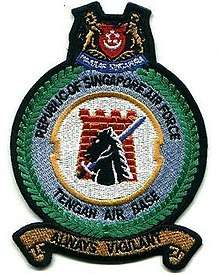 Tengah Air Base Station Badge | |||||||||||||||||||
| Summary | |||||||||||||||||||
| Airport type | Military airbase Airfield | ||||||||||||||||||
| Owner | Ministry of Defence (Singapore) | ||||||||||||||||||
| Operator | Republic of Singapore Air Force | ||||||||||||||||||
| Location | Western Water Catchment, Singapore | ||||||||||||||||||
| Elevation AMSL | 15 m / 50 ft | ||||||||||||||||||
| Coordinates | 01°23′14″N 103°42′31″E | ||||||||||||||||||
| Runways | |||||||||||||||||||
| |||||||||||||||||||
Prior to Singapore's independence, it was a flying Royal Air Force station known as RAF Tengah.
History
RAF Tengah

RAF Tengah was opened in 1939. Tengah airfield was the target of carpet bombing when 17 Japanese Navy bombers conducted the first air raid on Singapore, shortly after the Battle of Malaya began. It was also the first airfield to be captured when Japanese forces invaded Singapore.
After the Japanese capture of Singapore, Tengah came under the control of the Imperial Japanese Army Air Force while the Imperial Japanese Navy Air Service took over the other two RAF stations of Sembawang Air Base and RAF Seletar as Singapore was split into north-south sphere of control. This effectively ensured that the Japanese Army took control of the south, including the administrative hub and population centre of Singapore City, while the Japanese Navy took command of the north, which included the Royal Navy dockyard at Sembawang.
Malayan Emergency
During the Malayan Emergency, Tengah was used to house Avro Lincolns of the Royal Air Force and Royal Australian Air Force and Bristol Brigands of No 84 Squadron RAF which performed bombing sorties on communist terrorist bases/hideouts of the Malayan Communist Party deep in the jungles of Peninsular Malaysia. In 1952 No 45 Squadron was equipped with DH Hornets and re-equipped with DH Venoms in 1955 at RAF Butterworth when No 45 Squadron was amalgamated with No 33 Squadron] T.11's of 60 Squadron, joined by 14 Squadron of the Royal New Zealand Air Force. In 1958 they were joined by 45 Squadron and No. 75 Squadron RNZAF, both equipped with English Electric Canberra B.2. The RAAF retained their Lincolns, with 1 Squadron, until the end of the emergency.
Konfrontasi
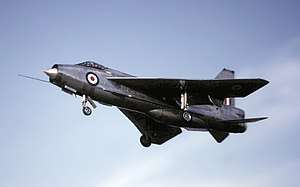
During the period of Indonesia–Malaysia confrontation 20 Squadron with its Hawker Hunter fighter aircraft in addition to the Gloster Javelins of 60 Squadron and 64 Squadron, were based on the airfield to help upgrade the air defence of Singapore and Peninsula Malaysia against infrequent air incursions from the MiG-21s and P-51 Mustangs of the Indonesian Air Force. 74 Squadron Lightnings were deployed following Confrontation to replace the Javelins of 64 Squadron.
On 3 September 1964, an Indonesian Air Force C-130 Hercules crashed into the Straits of Malacca while trying to evade interception by a Javelin FAW.9 of No 60 Squadron.[1] On 30 April 1968, the Gloster Javelins of No 60 Squadron flew their last RAF operational sorties from Tengah and the squadron was disbanded the same day.[2]
V bomber detachment

As a show of force to deter the Indonesian President Sukarno from launching an all-out war during this period, the RAF also deployed a V bomber force detachment to Tengah in the form of Handley Page Victor B.1A bombers from 15 Squadron in August 1963, which was rotated with those dispersed to RAAF Butterworth in Malaysia. The detachment of Victor bombers was replaced in October 1964 by a detachment of Avro Vulcan B.2 bombers from 12 Squadron, these were subsequently pulled back to RAF Akrotiri in December that same year. In August 1965, 9 Squadron resumed RAF's Vulcan bomber detachment to Tengah, followed by 35 Squadron in December 1965, these were in turn replaced by 9 Squadron again in February 1966. After June 1966, 9 Squadron returned to Akrotiri following the end of the confrontation.
According to British MOD documents declassified in 2000, up to 48 Red Beard tactical nuclear weapons were secretly stowed in a highly secured weapons storage facility at Tengah, between 1962 and 1970, for possible use by the V bomber force detachment and for Britain's military commitment to South East Asia Treaty Organization (SEATO).[3][4]
British Withdrawal
The RAF station closed at the end of March 1971 and Tengah was handed over to the Singapore Air Defence Command (later the Republic of Singapore Air Force) by 1973, after the British Withdrawal following the defence cuts. Despite this, the airfield continued to host British and Commonwealth air forces and troops under the auspices of the Five Power Defence Arrangements (FPDA) until 1976.
Tengah Air Base
It was renamed RSAF Tengah in 1971 (then it became Tengah Air Base (TAB)), when it was handed over to the Singapore Air Defence Command (SADC). Currently, the air base houses aircraft such as the Lockheed Martin F-16C/D Fighting Falcons.
RSAF50 parade took place on 1 September 2018 at TAB, the parade featured almost 500 personnel in a march-past, mobile column and a Salute-to-the-Nation flypast involving 20 aircraft, and the new Multi-Role Tanker Transport (MRTT) aircraft made its maiden public appearance. The static display also showcased both retired and present aircraft.[5][6][7]
Organization

Flying Squadrons
The Flying Squadrons based in Tengah Air Base are:[8]
- 111 Squadron with 4 G550 CAEW
- 140 Squadron with 12 F-16C/D
- 143 Squadron with 12 F-16C/D
- RSAF Black Knights – the official RSAF Aerobatic team with F-16Cs from various squadrons.
Support Squadrons
The Support Squadrons based in Tengah Air Base are:[10]
- Flying Support Squadron – 205 Squadron
- Airbase Civil Engineering Squadron – 505 Squadron
- Field Defence Squadron – 605 Squadron
- Ground Logistics Squadron – 705 Squadron
- Aircraft Operational Maintenance Squadron – 805 Squadron
- Aircraft Specialist Maintenance Squadron – 815 Squadron
Former Flying Squadrons
- 142 Squadron with 16 A-4SU Super Skyhawk before the squadron was disbanded in 1997, the squadron was reestablished in 2016 at Paya Lebar Air Base.
Exercises
The RSAF regularly conducts Exercise Torrent which converts the neighboring Lim Chu Kang road into an alternative runway since its inception in April 1986.[11] Its purpose is to demonstrate the RSAF capability of generating air power in the shortest time from public roads.[12] The latest and seventh edition was held from the 10 to 13 November 2016.[13]
Future
To accommodate the relocation of all RSAF assets and equipment from Paya Lebar Air Base in 2030, Tengah Air Base will be expanded by acquiring about 120 graves in Choa Chu Kang, and four nearby farms and agricultural businesses. A short stretch of Lim Chu Kang Road would also be re-aligned to run along outside the new perimeter of the expanded air base, alongside Murai Farmway in 2019, and another 1,000 graves will be exhumed in 2023. Another 10,000 graves will follow suit in 2024. 18,400 graves will be exhumed in 2026 - 2027 and 20,000 graves will be exhumed in 2029 - 2030, which will consist of 49,400 graves. Some of the training areas will be rationalised.[14][15] A new runway will be built on the expanded portion of the base.[16]
Photo gallery
 An aerial view of the RAF Tengah taken in 1953
An aerial view of the RAF Tengah taken in 1953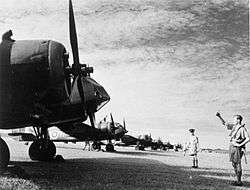 Bristol Blenheim Mk Is of No. 62 Squadron RAF lined up at RAF Tengah, February 1941
Bristol Blenheim Mk Is of No. 62 Squadron RAF lined up at RAF Tengah, February 1941 Bristol Blenheim Mk IV bombers at RAF Tengah, June 1941
Bristol Blenheim Mk IV bombers at RAF Tengah, June 1941 The first operation of No. 1 Squadron, Royal Australian Air Force from RAF Tengah, August 1950
The first operation of No. 1 Squadron, Royal Australian Air Force from RAF Tengah, August 1950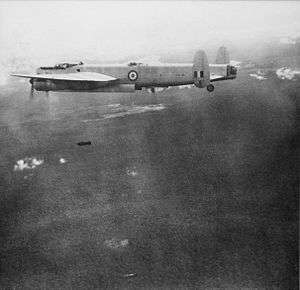 An Avro Lincoln bomber of No 1(B) Bomber squadron dropping 500 pound bombs on Communist targets during the Malayan Emergency
An Avro Lincoln bomber of No 1(B) Bomber squadron dropping 500 pound bombs on Communist targets during the Malayan Emergency Members of No. 45 Squadron RAF posing for the camera in front of a Bristol Brigand at RAF Tengah, in 1950
Members of No. 45 Squadron RAF posing for the camera in front of a Bristol Brigand at RAF Tengah, in 1950 English Electric Canberra B.15 of No. 45 Squadron at RAF Tengah, Singapore, in 1963
English Electric Canberra B.15 of No. 45 Squadron at RAF Tengah, Singapore, in 1963 RSAF F-16D prepares for flight
RSAF F-16D prepares for flight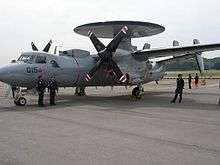 RSAF 111Sqn's E-2C Hawkeye
RSAF 111Sqn's E-2C Hawkeye
See also
- Republic of Singapore Air Force
- Singapore strategy
- British Far East Command
- Far East Air Force (Royal Air Force)
- Far East Strategic Reserve
- Former overseas RAF bases
- Battle of Singapore
- Malayan Emergency
- Bristol Brigands - No 84 Squadron at RAF Tengah during the Malayan Emergency
- Indonesia–Malaysia confrontation
References
- Citations
- Conboy, p. 161.
- Wixley, p. 422.
- Tom, Rhodes (31 December 2000). "Britain Kept Secret Nuclear Weapons in Singapore & Cyprus". The Sunday Times. United Kingdom: News International. Archived from the original on 31 December 2000. Retrieved 1 March 2011.
- "Vulcans in camera: Vulcans in the far east". Retrieved 1 March 2011.
- "At Trump-Kim summit, RSAF showed the world it was operationally ready: PM Lee". CNA.
- "RSAF to celebrate 50th birthday with new aerial displays, heartland exhibitions". CNA.
- "RSAF50 Announcement ⋆ MAphotoSG". 17 January 2018.
- "Air Combat Command (ACC)". Ministry of Defense (Singapore).
- "UAV Command (UC)". Ministry of Defense (Singapore).
- "Air Power Generation Command (APGC)". Ministry of Defense (Singapore).
- "RSAF Exercise Torrent 2016". 13 November 2016.
- "Getting It All Up". 11 November 2016.
- "Public road converted into fighter jet runway for Exercise Torrent". The Straits Times. 11 November 2016.
- "Government to exhume over 80,000 graves, acquire land to make way for Tengah Air Base expansion". CNA.
- "5 things to know about the expansion of Tengah Air Base". The Straits Times. 18 July 2017.
- "Reply to Media Queries on Expansion of Tengah Air Base and Relocation of Paya Lebar Air Base". www.mindef.gov.sg.
- Bibliography
- Conboy, Ken (2003). 'Kompassus' – Inside Indonesia's Special Forces. Jakarta: Equinox Publishing. ISBN 979-95898-8-6.
- Wixley, Kenneth E. "Gloster Javelin: a production history, Part 2". Aircraft Illustrated, September 1984, Vol. 17, No 9, pp. 420–422. ISSN 0002-2675.
External links
| Wikimedia Commons has media related to |
- RSAF web page on Tengah Air Base (TAB)
- Airport information for WSAT at World Aero Data. Data current as of October 2006.
- History of RAF
- Crest badge and Information of RAF Tengah
- The Brigand Boys at RAF Tengah
- Memories of Singapore – RAF Tengah
Video clips
- Exercise Torrent 2008 – Held on 29/30 November 2008, RSAF conducted a series of take-off and landing along Lim Chu Kang Road next to Tengah Air Base on YouTube, accessed 26 December 2008.
- CyberPioneer TV: From road to runway — the preparation leading up to Exercise Torrent 2008 on YouTube, accessed 23 January 2009.